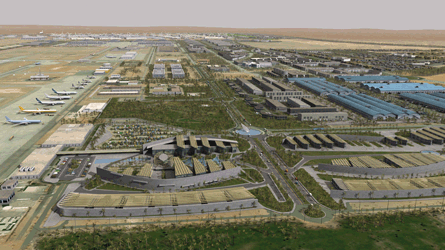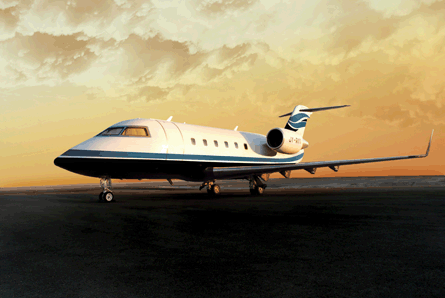Sandwiched between Israel and the West Bank, Iraq, Saudi Arabia and Syria - and almost bereft of natural resources - Jordan has had to make the most of the hand it has been dealt. Politically, it has played the honest broker in a turbulent region - even when its own existence was under threat - and, almost uniquely in the Middle East, enjoys friendly relations with all its neighbours.
King Hussein - who ruled the Hashemite kingdom from 1952 until his death in 1999 - was a keen pilot who saw aviation as one of sectors in which the largely desert nation could nurture a service- and knowledge-based economy. His policies have been continued by his successor, King Abdullah, and - thanks also to a strong entreprenueurial culture and education system - Jordan has one of the region's most developed aviation industries, despite its population of just six million.
The bedrock of the sector is flag-carrier Royal Jordanian, which, long before today's Gulf giants, was carrying Europeans to the cities of the Far East via Amman. The airline may have changed its strategy since, but a number of now privately-owned Royal Jordanian offshoots have become leading third-party service providers. These include maintenance, repair and overhaul house Jordan Aircraft Maintenance (Joramco), engine MRO specialist Jordan Airmotive and Jordan Airline Training and Simulation (JATS).
|
|---|
© RayaJet |
The kingdom has a modest defence industry centred on the state-owned King Abdullah II Design and Development Bureau, which includes Seabird Aviation Jordan, a manufacturer of light surveillance aircraft and the country's only airframer.
Jordan has also become a major centre for ab-initio flight training, with operators such as Ayla Aviation Academy. It is also emerging as a centre for business aviation, with charter providers such as Arab Wings and RayaJet challenging the dominance of Abu Dhabi and Dubai in a region where, despite the downturn, there is a sizeable entrepreneurial class prepared to pay for swift, private air travel.
Amman-based RayaJet was formed in 2005, starting charter operations under a Jordanian air operator's certificate with a Bombardier Challenger 601, and last year adding a Cessna Citation 650. A Beechcraft Premier II will join the fleet in early 2012. Although the global downturn has affected business aviation in Jordan and the surrounding countries, is still full of potential, says managing directorAta Sawalha. "The region is full of new, young businessmen looking for their own aeroplane at a good price," he says.
Alongside business flights around the region and to Europe, medevac services, launched last year, represent a quarter of RayaJet's activities, with Iraq and Yemen among the countries it serves. The company, which has its own maintenance operation and VIP lounge at the city's smaller Marka airport, has signed Lebanese pop singer Ragheb Alama as its "face" for the next year, partly because of his appeal across the Arab world.
Based in striking curved-roof twin hangars at Amman's main Queen Alia airport, and with 1,000 employees, Joramco has, in the decade since it was split from Royal Jordanian, become one of the Middle East's big two third-party MROs (alongside Abu Dhabi's ADAT). About three-quarters of its revenues come from customers other than its former parent; the airline remains a 20% shareholder in Joramco, alongside Abraaj Capital.
Specialising in Airbus and Embraer E-Jets (the core fleet of Royal Jordanian), as well as the Boeing 737, Joramco covers a region within 5-6h flying time of Amman, which takes in eastern and central Europe, the Indian subcontinent, north Africa and parts of Russia, says chief executive Bashir Abdel Hadi. Although its competitors are not just limited to the region - "An Indian operator can easily fly to Malaysia," he says - airlines' growing willingness to shop the world for lower-cost maintenance benefits all providers in "the south", where labour and land prices are more competitive. "Customers will evaluate us against each other, but the cake could be bigger for us all to share," says Abdel Hadi.
Apart from location, one of Joramco's strengths is its availability of skilled labour, he says. "Jordan is known for its education system, with nearly 30 universities and five aircraft maintenance schools. Being an aircraft engineer is a highly regarded career. This supply puts us at an advantage." The company established its own training academy two years ago, offering European Aviation Safety Agency-recognised qualifications. Abdel Hadi admits, however, that having such a strong education system can see young technicians lured to higher-paid jobs in the Gulf.
Abdel Hadi says a clear strategy of adding capacity and investing in technology and new capabilities such as composite repairs has helped Joramco triple its revenues since 2005 and firmly establish its brand in the market. "We are well on the way to taking Joramco to a world-class company," he says.
JATS has also flourished in the nine years since it became independent. Like Joramco, its near-neighbour at Queen Alia airport, the simulator training provider is 80% held privately - in its case, by Eastern Holding Group - with Royal Jordanian retaining 20%. Its former parent accounts for less than one-third of its business. With four full motion simulators - two Airbus A320s, an A310-300 and a Boeing 727 - JATS's clients include Syrian Arab Airlines, Gulf Air and airlines from around the Middle East, eastern Europe, the Indian subcontinent and North Africa.
"Our legacy is as RJ's training provider, but we are firmly on the world map," says Amjad Alamin, the company's head of simulators.
But the drop in pilot recruitment across the industry has hit the business. "It has been a tough year, but we have maintained our market share," says Alamin. Jordan's reputation as a stable, friendly, non-expensive country has been one of JATS's biggest assets, enabling airlines to send pilots of various nationalities to be trained in a secure environment, cost-effectively. "Jordan is in the middle of flames," says Alamin, alluding to the kingdom's troubled neighbours. "But everybody can come here without immigration problems."
AEROSPACE CITY BEGINS TO RISE FROM THE DESERT
The sleepy colonial-era airport and air base outside the oasis town of Al Ain may not look much like prime real estate. But the bulldozers flattening a vast expanse of surrounding desert and a scale model in the airport office lobby give a glimpse of Abu Dhabi's vision for a self-sustaining aerospace city already taking shape among the sand dunes.
At one end of the airport, ground is being cleared for Strata, a composites manufacturing plant run by Mubadala Aerospace - part of Abu Dhabi's state-owned investment arm - in partnership with EADS and Finmeccanica subsidiary Alenia Aeronautica. The 21,600m2 facility will begin manufacturing at the end of 2010, including flap track fairings, ailerons and spoilers for Airbus and empennages for ATR, which is co-owned by the European companies.
 |
|---|
An artist's impression of the Al Ain complex |
The plant will employ 500 staff initially, although Mubadala expects this to rise to more than 1,000 by 2020 as the development grows.
Around the anchor facility, Abu Dhabi Airports Company (ADAC) wants to persuade small and medium-size enterprises to set up shop, supplying Strata and other manufacturers, or other services such as maintenance and logistics. The scheme to market the aerospace cluster was launched at the Paris air show this year, where a number of SMEs and trade groupings from Germany and the UK signed memoranda of understanding to establish businesses at Al Ain. Further agreements are expected to be announced at the Dubai air show.
One of the biggest attractions for western investors, says Azza Al Zaabi, head of planning at Al Ain airport, will be the quality of life they will be able to offer employees. ADAC will create a "city within a city" at Al Ain, providing fixed-cost housing as well as health and education and leisure facilities including a golf course. An initial 500 apartments will be open by 2011 for those working at Strata and ADAC expects around 5,000 people to be living at the airport development within six years.
Al Ain - the original home of Abu Dhabi's ruling family - may not offer the high-rise, metropolitan intensity of Dubai or Abu Dhabi city, each 90min of desert highway distant. Instead, expatriate employees will be able to secure more living space for their buck than they would in these bigger cities and enjoy a self-contained, family-oriented lifestyle, says Al Zaabi, a native of Al Ain. "We want to develop a community where the majority will be expats," she adds. "But we also want to maintain the identity of our city."
Source: Flight International

















